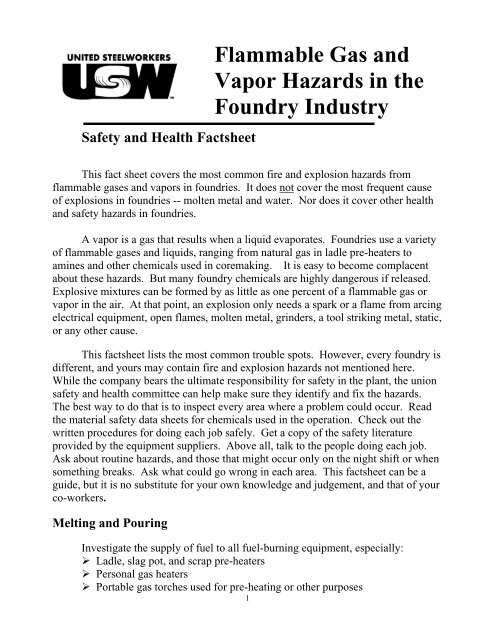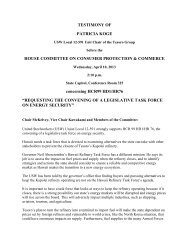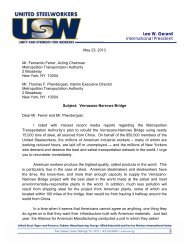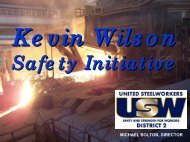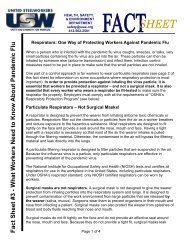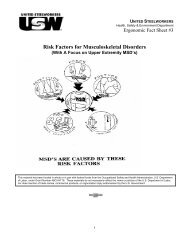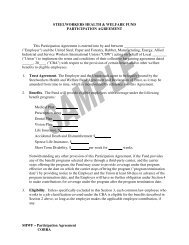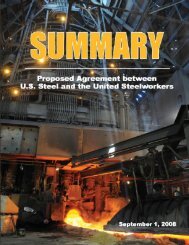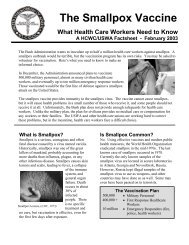Flammable Gas and Vapor Hazards in the Foundry Industry - United ...
Flammable Gas and Vapor Hazards in the Foundry Industry - United ...
Flammable Gas and Vapor Hazards in the Foundry Industry - United ...
You also want an ePaper? Increase the reach of your titles
YUMPU automatically turns print PDFs into web optimized ePapers that Google loves.
Safety <strong>and</strong> Health Factsheet<br />
<strong>Flammable</strong> <strong>Gas</strong> <strong>and</strong><br />
<strong>Vapor</strong> <strong>Hazards</strong> <strong>in</strong> <strong>the</strong><br />
<strong>Foundry</strong> <strong>Industry</strong><br />
This fact sheet covers <strong>the</strong> most common fire <strong>and</strong> explosion hazards from<br />
flammable gases <strong>and</strong> vapors <strong>in</strong> foundries. It does not cover <strong>the</strong> most frequent cause<br />
of explosions <strong>in</strong> foundries -- molten metal <strong>and</strong> water. Nor does it cover o<strong>the</strong>r health<br />
<strong>and</strong> safety hazards <strong>in</strong> foundries.<br />
A vapor is a gas that results when a liquid evaporates. Foundries use a variety<br />
of flammable gases <strong>and</strong> liquids, rang<strong>in</strong>g from natural gas <strong>in</strong> ladle pre-heaters to<br />
am<strong>in</strong>es <strong>and</strong> o<strong>the</strong>r chemicals used <strong>in</strong> coremak<strong>in</strong>g. It is easy to become complacent<br />
about <strong>the</strong>se hazards. But many foundry chemicals are highly dangerous if released.<br />
Explosive mixtures can be formed by as little as one percent of a flammable gas or<br />
vapor <strong>in</strong> <strong>the</strong> air. At that po<strong>in</strong>t, an explosion only needs a spark or a flame from arc<strong>in</strong>g<br />
electrical equipment, open flames, molten metal, gr<strong>in</strong>ders, a tool strik<strong>in</strong>g metal, static,<br />
or any o<strong>the</strong>r cause.<br />
This factsheet lists <strong>the</strong> most common trouble spots. However, every foundry is<br />
different, <strong>and</strong> yours may conta<strong>in</strong> fire <strong>and</strong> explosion hazards not mentioned here.<br />
While <strong>the</strong> company bears <strong>the</strong> ultimate responsibility for safety <strong>in</strong> <strong>the</strong> plant, <strong>the</strong> union<br />
safety <strong>and</strong> health committee can help make sure <strong>the</strong>y identify <strong>and</strong> fix <strong>the</strong> hazards.<br />
The best way to do that is to <strong>in</strong>spect every area where a problem could occur. Read<br />
<strong>the</strong> material safety data sheets for chemicals used <strong>in</strong> <strong>the</strong> operation. Check out <strong>the</strong><br />
written procedures for do<strong>in</strong>g each job safely. Get a copy of <strong>the</strong> safety literature<br />
provided by <strong>the</strong> equipment suppliers. Above all, talk to <strong>the</strong> people do<strong>in</strong>g each job.<br />
Ask about rout<strong>in</strong>e hazards, <strong>and</strong> those that might occur only on <strong>the</strong> night shift or when<br />
someth<strong>in</strong>g breaks. Ask what could go wrong <strong>in</strong> each area. This factsheet can be a<br />
guide, but it is no substitute for your own knowledge <strong>and</strong> judgement, <strong>and</strong> that of your<br />
co-workers.<br />
Melt<strong>in</strong>g <strong>and</strong> Pour<strong>in</strong>g<br />
Investigate <strong>the</strong> supply of fuel to all fuel-burn<strong>in</strong>g equipment, especially:<br />
‣ Ladle, slag pot, <strong>and</strong> scrap pre-heaters<br />
‣ Personal gas heaters<br />
‣ Portable gas torches used for pre-heat<strong>in</strong>g or o<strong>the</strong>r purposes<br />
1
Make sure that all fuel l<strong>in</strong>es <strong>and</strong> valves are designed for <strong>the</strong> fuel <strong>the</strong>y carry.<br />
(Some foundries have been caught us<strong>in</strong>g water hoses <strong>and</strong> valves for gas, a very<br />
dangerous practice.) Make sure all gas-fired equipment is protected with a regulator<br />
<strong>and</strong> automatic shut-off valve. Make sure <strong>the</strong> l<strong>in</strong>es are guarded aga<strong>in</strong>st be<strong>in</strong>g cut or<br />
broken by mobile equipment. Make sure that <strong>the</strong> equipment uses <strong>the</strong> fuel it was<br />
designed for. Although it is not <strong>the</strong> subject of this factsheet, this would be a good<br />
time to check for <strong>the</strong> possibility of an explosion caused by molten metal <strong>and</strong> water.<br />
Mold<strong>in</strong>g <strong>and</strong> Core Mak<strong>in</strong>g<br />
In some cases, Class I flammable liquids or gases (<strong>the</strong> most dangerous ones)<br />
are used <strong>in</strong> this process. Two of <strong>the</strong> most common are dimethylethylam<strong>in</strong>e (DMEA),<br />
<strong>and</strong> triethylam<strong>in</strong>e (TEA). Make sure <strong>the</strong>re is a material safety data sheet (MSDS) for<br />
every chemical. Study <strong>the</strong> MSDSs carefully. As <strong>in</strong> <strong>the</strong> melt<strong>in</strong>g <strong>and</strong> pour<strong>in</strong>g area,<br />
look at equipment us<strong>in</strong>g natural gas, LPG, kerosene, <strong>and</strong> o<strong>the</strong>r fuels. It is especially<br />
important to check:<br />
‣ <strong>Gas</strong>-fired hot box core or mold<strong>in</strong>g mach<strong>in</strong>es<br />
‣ Cold box core mach<strong>in</strong>es<br />
‣ Personal gas heaters<br />
Check <strong>the</strong> equipment for potential leaks. The am<strong>in</strong>es listed above have a strong<br />
fishy smell, but o<strong>the</strong>r core mak<strong>in</strong>g chemicals are odorless. Look at <strong>the</strong> entire system,<br />
start<strong>in</strong>g from <strong>the</strong> way <strong>the</strong> chemicals are received <strong>in</strong>to <strong>the</strong> plant, to <strong>the</strong> l<strong>in</strong>es for gett<strong>in</strong>g<br />
<strong>the</strong> chemicals <strong>in</strong>to molds <strong>and</strong> cores, to <strong>the</strong> h<strong>and</strong>l<strong>in</strong>g of used conta<strong>in</strong>ers. Ask workers<br />
<strong>in</strong> <strong>the</strong> area about past leaks. Some of <strong>the</strong>se chemicals are toxic, so leaks too small to<br />
cause an explosion could cause health problems.<br />
F<strong>in</strong>ish<strong>in</strong>g <strong>and</strong> Heat Treat<strong>in</strong>g<br />
Most foundries have f<strong>in</strong>ish<strong>in</strong>g <strong>and</strong> heat treat<strong>in</strong>g facilities, us<strong>in</strong>g flammable<br />
gases <strong>and</strong> liquids. It is especially important to check:<br />
‣ Fuel gases used <strong>in</strong> weld<strong>in</strong>g, cutt<strong>in</strong>g, <strong>and</strong> braz<strong>in</strong>g<br />
‣ Heat treat<strong>in</strong>g furnaces<br />
‣ Portable gas torches used for pre-heat<strong>in</strong>g<br />
‣ Fuel gases used for mobile equipment, like fork trucks<br />
Be sure to look at how <strong>the</strong> fuels are received <strong>and</strong> stored, as well as how <strong>the</strong>y<br />
are used.<br />
2
Pattern/Wood Work<strong>in</strong>g Shops<br />
Numerous flammable liquids are used <strong>in</strong> <strong>the</strong>se areas, some of <strong>the</strong>m Class I.<br />
Wood <strong>and</strong> plastic dust can also be explosive if suspended <strong>in</strong> <strong>the</strong> air. Be sure to check:<br />
‣ Wood <strong>and</strong> plastic dust from s<strong>and</strong><strong>in</strong>g <strong>and</strong> gr<strong>in</strong>d<strong>in</strong>g<br />
‣ Pa<strong>in</strong>ts, th<strong>in</strong>ners, lacquers <strong>and</strong> shellacs used to cover patterns <strong>and</strong> o<strong>the</strong>r<br />
surfaces<br />
‣ Ventilation systems carry<strong>in</strong>g dust, to ensure <strong>the</strong>y are kept clean, <strong>and</strong> have<br />
spark arrestors<br />
‣ Personal gas heaters<br />
‣ Heat-produc<strong>in</strong>g portable tools<br />
Shipp<strong>in</strong>g <strong>and</strong> Receiv<strong>in</strong>g<br />
Most hazardous materials used <strong>in</strong> <strong>the</strong> plant come through <strong>the</strong>se areas. You<br />
should carefully evaluate how flammable <strong>and</strong> combustible material is received,<br />
shipped, <strong>and</strong> stored. Be sure to <strong>in</strong>clude:<br />
‣ <strong>Flammable</strong> liquids <strong>and</strong> gases, <strong>in</strong>clud<strong>in</strong>g fuel gases <strong>in</strong> cyl<strong>in</strong>ders<br />
‣ <strong>Flammable</strong> solids<br />
‣ Personal gas heaters<br />
‣ Oxygen cyl<strong>in</strong>ders. Although oxygen is not flammable, it will greatly<br />
accelerate combustion.<br />
Ma<strong>in</strong>tenance Areas<br />
These areas also conta<strong>in</strong> fire <strong>and</strong> explosion hazards. Check <strong>the</strong> general<br />
housekeep<strong>in</strong>g, <strong>and</strong> <strong>the</strong> storage <strong>and</strong> use of:<br />
‣ Grease, oil, solvents, <strong>and</strong> flammable liquids<br />
‣ Fuel gases <strong>in</strong> cyl<strong>in</strong>ders used <strong>in</strong> weld<strong>in</strong>g, cutt<strong>in</strong>g, <strong>and</strong> braz<strong>in</strong>g<br />
‣ Personal gas heaters<br />
‣ Portable gas torches used for pre-heat<strong>in</strong>g<br />
Metallurgical Labs<br />
In addition to <strong>the</strong> usual hazards of flammable liquids <strong>and</strong> gases, met labs also<br />
conta<strong>in</strong> chemicals like strong acids, which can react violently with flammable liquids<br />
to cause a fire or explosion. Be sure to look for:<br />
‣ <strong>Flammable</strong> gases, liquids, <strong>and</strong> solids<br />
‣ Reactive chemicals such as acids or corrosives<br />
‣ Bunsen burners <strong>and</strong> o<strong>the</strong>r heat<strong>in</strong>g devices<br />
‣ Personal gas heaters<br />
3
O<strong>the</strong>r<br />
General<br />
‣ Calcium carbide is sometimes used to produce ductile iron. When exposed<br />
to water or moisture, it will produce explosive acetylene gas. Check <strong>the</strong><br />
calcium carbide storage <strong>and</strong> use.<br />
Keep <strong>in</strong> m<strong>in</strong>d that many flammable gases <strong>and</strong> vapors are heavier than air <strong>and</strong><br />
will accumulate <strong>in</strong> low-ly<strong>in</strong>g areas such as cellars, basements <strong>and</strong> pits. One<br />
exception is hydrogen, which is lighter than air <strong>and</strong> has a tendency to rise.<br />
<strong>Flammable</strong> gases <strong>and</strong> vapors will ride <strong>the</strong> air currents. When <strong>the</strong> gas or vapor f<strong>in</strong>ds a<br />
spark or flame, it will flash back to its source.<br />
A good preventative ma<strong>in</strong>tenance program is essential for all gas or liquid-fired<br />
equipment. All equipment that could cause a fire or explosion should be <strong>in</strong>cluded <strong>in</strong><br />
a regular <strong>in</strong>spection, ma<strong>in</strong>tenance, <strong>and</strong> repair program. In addition, <strong>the</strong> safety <strong>and</strong><br />
health committee should <strong>in</strong>clude this equipment on <strong>the</strong>ir regular safety tours.<br />
This factsheet was prepared by <strong>the</strong> Health, Safety <strong>and</strong> Environment Department of <strong>the</strong><br />
<strong>United</strong> Steelworkers, 5 Gateway Center, Pittsburgh, PA 15222. Contact us for more<br />
<strong>in</strong>formation, or if you have any suggestions for improv<strong>in</strong>g this factsheet. Our phone is<br />
(412) 562-2581; our fax, (412) 562-2584; email: safety@usw.org<br />
(Updated, 3/24/00)<br />
4


